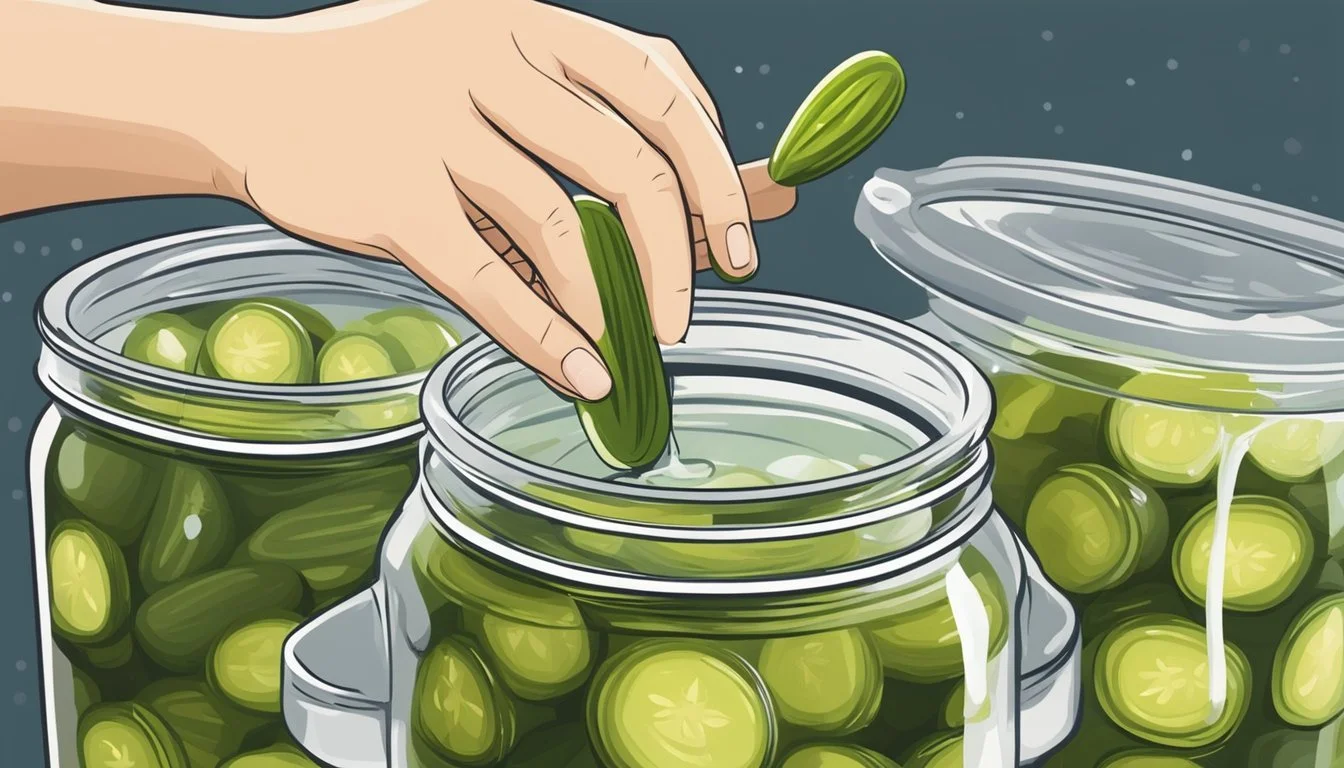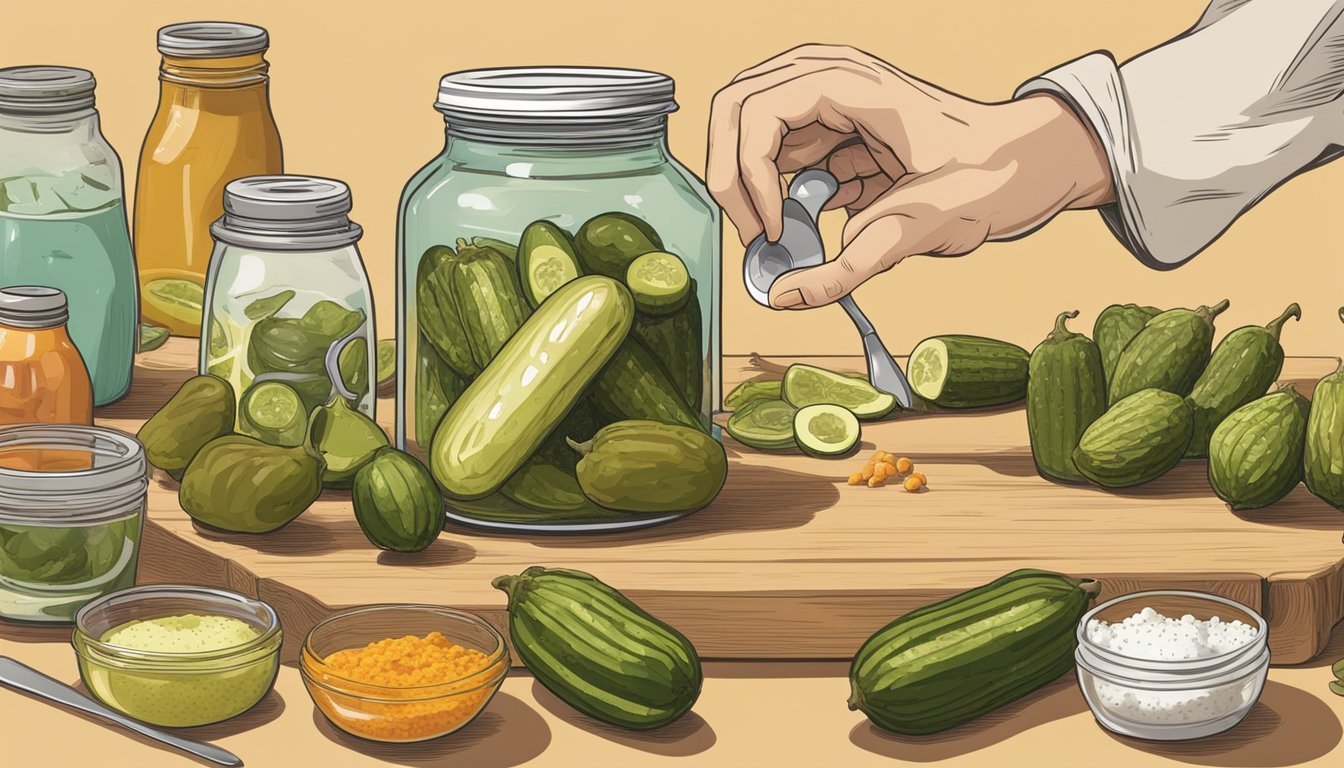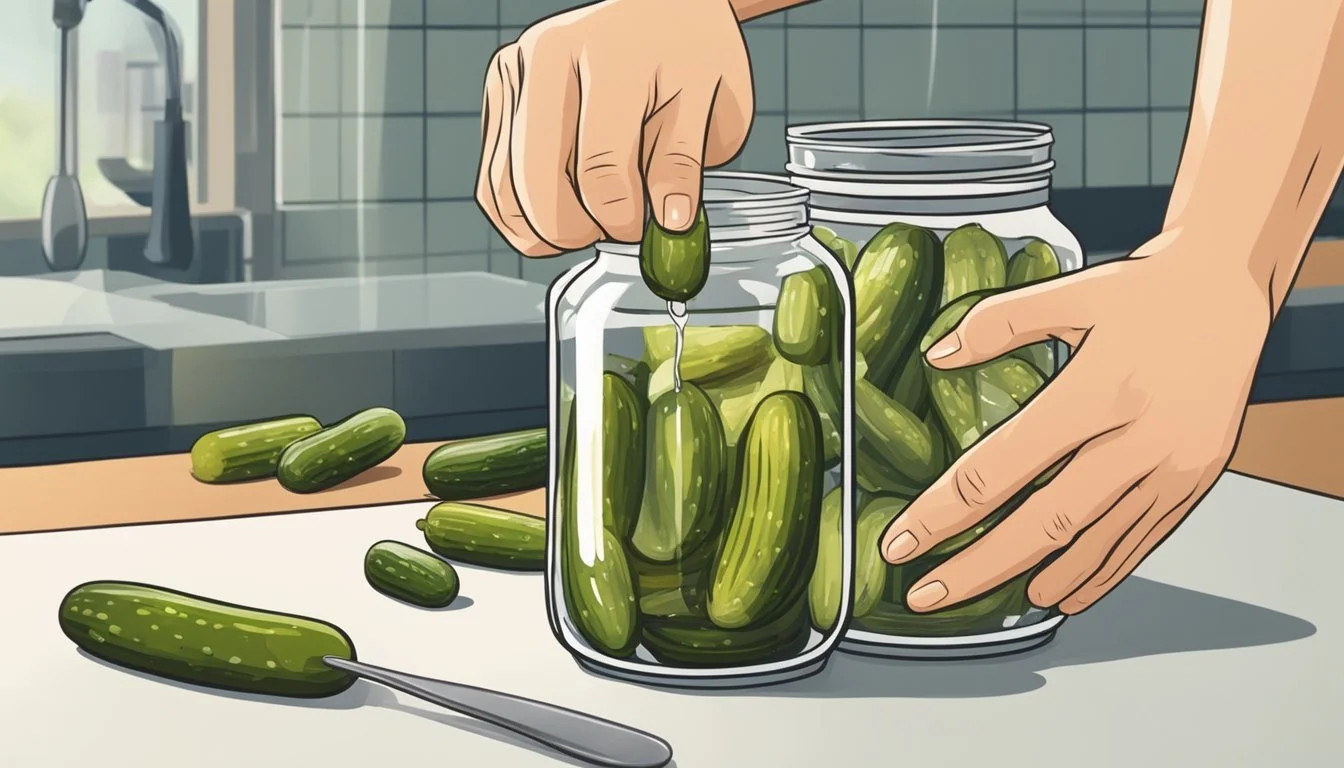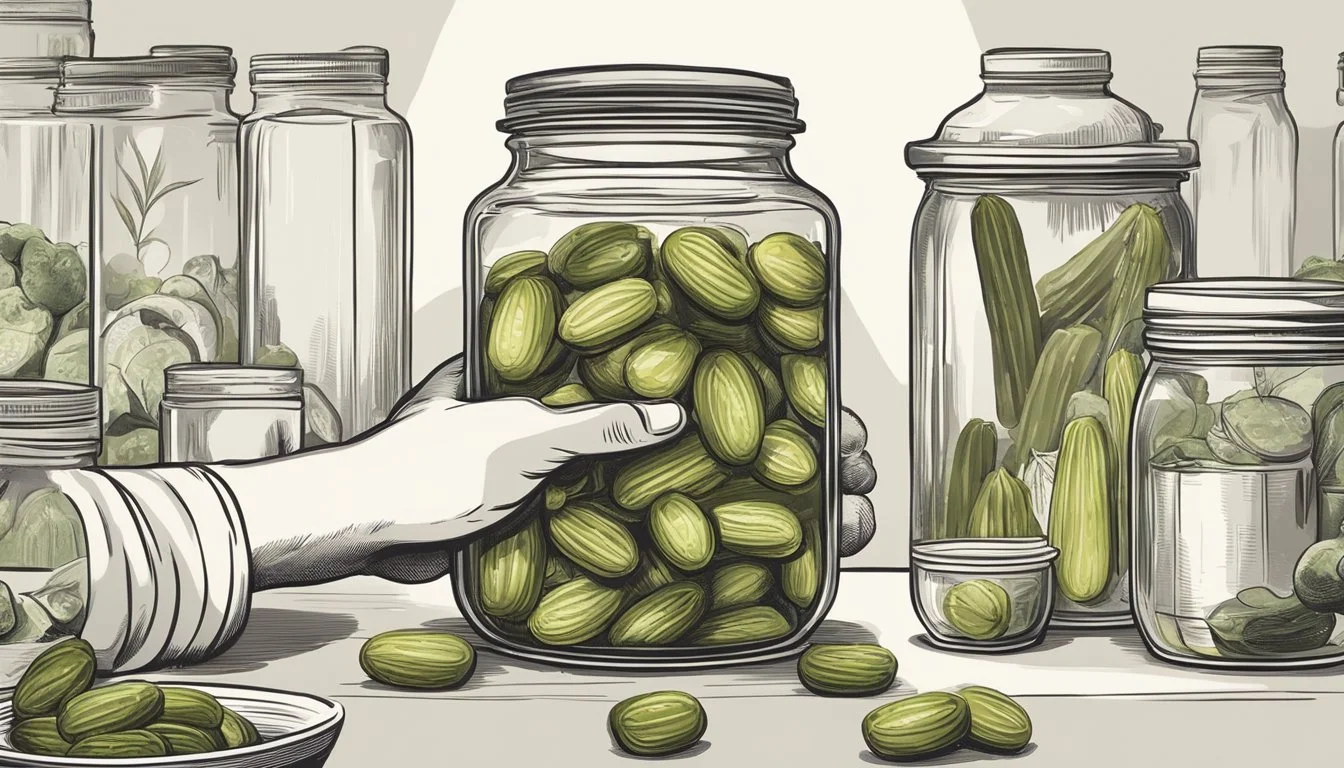Fixing Overly Salty Pickles
A Guide to Achieving the Perfect Brine Balance
A common challenge faced by homemade pickle enthusiasts is achieving the perfect balance of flavors in their brine. While pickling is a revered tradition in many cuisines, and a marvelous way to extend the shelf life of fresh produce, it can occasionally lead to the creation of overly salty pickles. This can disrupt the delicate harmony of taste and spoil the enjoyment of this preserved delicacy. Fortunately, there are several methods available to correct this issue without having to discard an entire batch of pickles.
The key to fixing salty pickles lies in understanding the elements that contribute to the brine's flavor profile. Salt is essential in pickling for both its preservative qualities and its ability to enhance taste, but its dominance should be counteracted if it becomes overpowering. Adjustments can be made by carefully introducing additional ingredients or by altering the existing brine. Through trial and error, one can learn to recalibrate the salinity to a desirable level, ensuring that the pickles are both safe to eat and enjoyable in their flavor.
Understanding Brine and Saltiness
In the world of pickling, achieving the perfect balance of flavors is an art, where salt plays a fundamental role in both preservation and taste. This section decodes the complexity of brine and its saltiness, crucial for both novice and seasoned pickle enthusiasts.
The Role of Salt in Pickling
Salt in pickling serves as more than just a flavor enhancer; it's pivotal in the preservation process. By creating a high-saline environment, salt inhibits bacterial growth, ensuring the food remains safe and extends its shelf life. It draws out water from the food through osmosis, contributing to a crisp texture. The types of salt used in brining can vary, but common choices include:
Table salt: Often used due to its fine grain and consistent flavor.
Kosher salt: Preferred for its pure flavor and ease of measurement.
Sea salt: Chosen for the unique taste from trace minerals.
The proportion of salt to water, typically called the brine solution, can affect the final taste. Here are some common ratios:
Light brine: 2-3% salt to water ratio, often used for delicate flavors.
Medium brine: 3.5-5% ratio, a standard for many recipes.
Heavy brine: 5-8% ratio, for a robust, preserved flavor.
Factors Contributing to Overly Salty Pickles
Several factors can contribute to an excess of saltiness in pickles, throwing the balance of flavors off-kilter. Some of these factors include:
Prolonged brining times: Leaving food in the brine solution for too long can lead to over-salted pickles.
Incorrect salt measurements: Using more salt than a recipe calls for can intensify the saltiness.
Type of salt used: Different salts have varying levels of saltiness; for instance, table salt is denser than kosher salt, so it could result in a saltier brine if used interchangeably.
Acidity, introduced via vinegar in the pickling process, plays a balancing act with saltiness. Vinegar adds tartness and tang and can help counteract the sensation of salt on the palate. However, an excess can overshadow the subtle flavors of the spices, such as dill, commonly used in pickling recipes.
By understanding these elements, one can better navigate the fine line between flavorful and overly salty pickles.
Common Causes of Excess Salinity
Excess saltiness in pickles can result from inaccuracies in preparation or the choice of ingredients. Understanding the common causes is essential to prevent and fix overly salty pickles.
Mistakes in Salt Measurement
One primary cause of overly salty pickles is incorrect measurement of salt. Accurate measurement is crucial; too much salt during the pickling process results in an imbalanced brine. Pickle makers should use precise measuring tools and verify the salt quantity against a reliable recipe.
Variations in Salt Types and Vinegar
The variety of salt and vinegar used can also contribute to excess salinity. Different salts have varying levels of density and saltiness. For instance, table salt is denser than kosher salt, so using the same volume can lead to a saltier product. In vinegar selection, the type could alter the perceived saltiness. White vinegar is sharper, potentially making the brine seem saltier. Conversely, milder vinegars like apple cider vinegar or rice vinegar may produce a less salty flavor profile. Here's a quick guide to vinegar types:
Apple Cider Vinegar: Milder with a fruity taste.
White Vinegar: Sharp and strong, can enhance salty taste.
Distilled White Vinegar: A clear, crisp flavor and could contribute to a sharper salty flavor.
Red Wine Vinegar: Less sharp with a subtle wine flavor.
Rice Vinegar: Gentler and slightly sweet.
Balsamic Vinegar: Rich, sweet, and complex, less common in pickling due to its dominant flavor.
Each vinegar type interacts uniquely with salt, impacting the final taste of pickles. Using the appropriate type and measuring accurately can prevent excess saltiness.
Corrective Measures for Salty Pickles
In cases where pickles have emerged from the brining process with an overabundance of salt, there are reliable methods to mitigate the saltiness. Both diluting the brine and adjusting the soaking and rinsing procedures can return the pickles to a palatable level of salinity.
Diluting the Brine
To reduce salt concentration, individuals can dilute the existing brine. This involves:
Adding water: By introducing additional water into the pickles' jar, one effectively reduces the salt-to-water ratio.
Shaking Jars: After adding water, ensure even distribution by gently shaking the sealed jars.
One should let the pickles sit in this newly adjusted brine for at least a day before conducting a taste test to determine if the desired balance of flavors has been achieved.
Soaking and Rinsing Procedures
If dilution does not effectively reduce saltiness, soaking the cucumbers can be the next logical step.
Rinsing the Pickles: Begin by thoroughly rinsing the pickles under cool, running water. This initial step can wash away excess surface salt.
Soaking: After rinsing, submerge the cucumbers in fresh water, allowing them to soak. The duration of soaking might vary from ten minutes to several hours, depending on the initial saltiness and thickness of the pickles.
Periodically taste the cucumbers during the soaking process to monitor the reduction of saltiness. Care must be taken not to oversoak as this could lead to a loss of flavor and a diminished pickle texture.
Balancing Brine Flavors
When a pickle batch turns out too salty, it's crucial to know how to balance flavors without compromising the food's safety or quality. Two effective methods for correcting the salt balance involve using sweeteners or introducing aromatics and acidifiers.
Using Sweeteners to Counteract Saltiness
To mitigate excessive saltiness, sweeteners can be introduced to the brine. Here are common options:
Sugar: A classic choice, adding sugar to the brine can balance saltiness.
Honey: A natural sweetener that adds a subtle floral note.
Brown Sugar: Offers a deeper, molasses-like flavor along with its sweetness.
A Table of Sweetener Ratios might look like the following:
Sweetener Amount for 1 cup of Brine Sugar 1 teaspoon Honey 1 ½ teaspoons Brown Sugar 1 teaspoon
One should start with these amounts and adjust based on taste after fully dissolving the sweetener in the brine.
Incorporating Aromatics and Acidifiers
Aromatics and acidifiers can also help to balance out a salty flavor profile. The addition of the following can introduce complexity and tanginess:
Herbs: Such as dill or bay leaves to add a distinct fragrance.
Garlic: Introduces a pungent flavor that complements the brine.
Spices: Mustard seeds and peppercorns add sharpness and heat.
To reduce saltiness, introducing acidifiers is a smart approach:
Adding Vinegar: It brings a sharp, tangy taste that counters salt.
Lemon Juice: Adds a fresh, citrus zing to the pickle brine.
In practice, one might add a tablespoon of vinegar or lemon juice to a cup of brine and taste test before adding more. The use of acidifiers should be done cautiously to prevent overpowering the pickles with acidity.
Adjusting Pickles Consistency
Achieving the right consistency in pickled vegetables, (What wine goes well with pickled vegetables?) such as cucumbers, carrots, and radishes, involves specific techniques, especially to maintain that desirable crunch. The fermentation process is crucial in this regard, and appropriate methods can enhance the firmness of these crisp vegetables.
Methods for Crispier Vegetables
To ensure vegetables remain firm and crisp during pickling, it is imperative to use fresh produce. Vegetables tend to lose their crispness over time, so the fresher the vegetable, the crisper the final product. Here are some specific methods:
Use of Calcium Chloride (Pickle Crisp): Adding a small amount of calcium chloride to the brine can increase the firmness of pickled vegetables.
Trimming the Ends: For cucumbers, trimming the blossom end can prevent enzymes from softening the pickle, as these enzymes can contribute to limp pickles.
Ice Water Bath: Soaking vegetables, like cucumbers and carrots, in ice water before pickling can enhance their crispness.
Tannins Addition: Incorporating natural sources of tannins, such as grape leaves, tea leaves, or oak leaves, into the pickling jar can help maintain the crunchiness of the vegetables.
Proper Storage: Storing the vegetables in a cool place before and after pickling helps retain their firm texture.
These techniques aid in preserving the crunchiness of vegetables throughout the fermentation process and beyond, ensuring a consistently crisp texture in homemade pickles.
Alternative Techniques for Fixing Salty Pickles
If standard methods like soaking pickles to reduce salinity prove insufficient, there are other innovative approaches one can take. These alternatives not only enhance the flavor balance but also integrate seamlessly with various dishes.
Food Pairings to Neutralize Saltiness
Pairing salty pickles with the right food items can offset their high sodium levels. Meats—which often benefit flavor-wise from a hint of salt—can effectively neutralize excess salinity when served together with pickles. Compiling a plate with a salty pickle and a dish of rich meat can enhance the overall taste experience without overwhelming the palate. Similarly, adding sweet and mild vegetables like carrots or spicy peppers can provide a flavor contrast that strikes a pleasant balance, making the pickle's saltiness less pronounced. Here is a brief list of food pairings:
Meat-based dishes: An ideal choice because the natural juices can mingle with the salt.
Carrot sticks: Their sweetness can counterbalance the salt.
Roasted peppers: The char and heat offer a bold counterpoint.
Utilizing Potatoes in Brine Correction
Potatoes have a well-documented ability to absorb excess salt, making them a useful tool for brine correction. By placing a few slices of raw potato into the briny solution, the potatoes start to draw out some of the salt from the liquid. The duration for which one leaves them in the jar should be monitored to avoid overcorrection. Below are steps that detail this process:
Slice a potato into thin pieces to maximize the surface area.
Place the slices into the pickle jar.
Allow them to sit for a short period, after which one should sample a pickle for improved taste.
Remove the potato slices once the desired salinity level is achieved.
The potato method works best when the goal is not just to reduce salt, but to also maintain the overall integrity and flavor profile of the pickles. They provide an unobtrusive way to neutralize high salinity without adding competing flavors.
Advanced Pickling Tips
In advanced pickling practices, one navigates the delicate balance of flavors in a salt brine, often through adjusting fermented pickles and exploring a variety of pickling spices. The following subsections delve deeper into these sophisticated techniques.
Fermented Pickle Adjustments
When adjusting fermented pickles, such as kimchi or traditional cucumber pickles, one must attend closely to the salt brine concentration. Fermented pickles rely on salt for both flavor and the preservation process. To correct an over-salted batch without disrupting fermentation, dilution is key. The brine can be carefully diluted with water, but one must ensure the salt level remains adequate for fermentation to proceed.
Dilution: Add water in small increments until the desired saltiness is achieved.
Tasting: Periodically taste the pickles to monitor for flavor balance.
Exploring Different Pickling Spices
The complexity of pickle flavors can be greatly enhanced by a well-chosen blend of pickling spices. Traditional spices include mustard seeds, dill, and black peppercorns, but incorporating ginger, fennel, or turmeric can introduce new dimensions to your pickles.
Ginger: Adds a warm, spicy note. Best used in thin slices or grated.
Fennel: Offers a sweet, licorice-like taste. Use seeds or fronds for different flavor intensities.
Turmeric: Imparts a golden hue and earthy bitterness. A small amount goes a long way.
When incorporating these spices, one should always consider the complementary flavors and how they might evolve over the course of fermentation.
Storage and Preservation
Effective storage and preservation are crucial for maintaining the quality and flavor of homemade pickles. Both canning and refrigeration play important roles in the longevity of these preserved items.
Proper Canning and Refrigeration Techniques
For canning, meticulous cleanliness and adherence to safety guidelines are paramount. The user must ensure that the canning jars and seals are sterile and that they follow a tested canning process. Canning is suitable for long-term storage and involves sealing the pickles in jars at a high temperature to prevent spoilage.
Sterilization: Boil canning jars and lids for at least 10 minutes.
Filling: Pack pickles into jars, leaving the correct headspace as recommended by guidelines.
Sealing: Process the filled jars in boiling water or a pressure canner according to the acidity level of the pickles.
For refrigeration, homemade pickles should be stored in air-tight containers to retain their crunchiness and prevent them from absorbing odors. Pickles in the fridge are generally meant for quicker consumption, and they should be kept in the coldest part of the refrigerator, which is usually at the bottom or at the back.
Temperature: Keep refrigerated at 35-38°F (1.7-3.3°C).
Airtight Containers: Use containers that seal tightly to maintain freshness.
Homemade pickles can last several months when canned properly and up to several weeks when stored in the refrigerator. It's essential to label the containers or jars with the date of canning or refrigeration to track their shelf life.
Serving and Enjoying Adjusted Pickles
Once the pickles have been suitably adjusted to reduce their saltiness, it's time to think about serving. After all, pickle enthusiasts look forward to the moment they can savor their carefully balanced treats. Here are some tips to ensure that every dish featuring these pickles is as delightful as intended.
Preparation:
First, let the pickles reach the desired taste through the adjustment process. Then, chefs remove them from the soak and pat them dry. This step prevents any additional water from diluting the flavor of the food they'll complement.
Serving Suggestions:
As a Standalone Snack: Serve the adjusted pickles on a platter, either whole or sliced, allowing the natural flavors to shine through.
In Salads: Chop the pickles and add them to salads for a bright, tangy crunch.
With Sandwiches: Include thin slices of pickles in sandwiches to add a hint of zest and texture.
Table Presentation:
Accompaniment Description Cheese Pairs well with sharp varieties Cold Cuts Offers a contrast in textures Crackers Adds a neutral flavor base
Tips for Food Pairing:
Contrast is key. The vinegar taste of pickles contrasts well with rich and creamy foods, like cheese or certain types of meat.
Consider the pickle's new flavor profile when adding it to a dish; different methods of desalting can slightly alter their taste.
Remember, the goal is to strike a balance where the unique flavor of the pickles complements the food without overpowering it. They should support and enhance the overall flavor experience of the dish they accompany.








